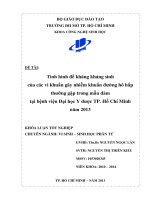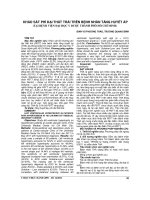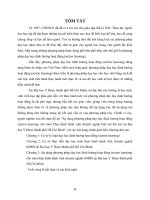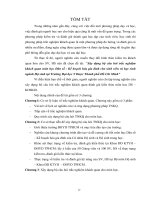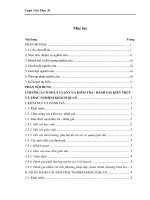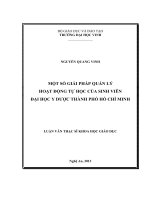Tăng huyết áp Y3 Đại học Y dược thành phố Hồ Chí Minh
Bạn đang xem bản rút gọn của tài liệu. Xem và tải ngay bản đầy đủ của tài liệu tại đây (1.21 MB, 36 trang )
1
TĂNG HUYẾT ÁP
PGSTS. CHÂU NGỌC HOA
GIẢNG VIÊN – ĐHYD
MỤC TIÊU
1.
Nêu dòch tễ học tăng huyết áp
2.
Mô tả cách đo huyết áp
3.
Phân độ được huyết áp
4.
Mô tả lâm sàng THA
5.
Đề nghò được xét nghiệm cho THA
Physicians knew about Blood
Pressure in the 1700’s
But didn’t have a way to measure
1901 model
» In 1905, Russian surgeon Nikolai Korotkoff
developed the modern technique of using a
stethoscope to listen for the sounds of blood
flowing through the artery. His method proved to be
extremely accurate and led to the discovery of
hypertension.
Tong quan
-
Bệnh THA là bệnh thường gặp, có xu hướng tăng
ở các nước đang phát triển
-
Bệnh còn có tỷ lệ tử vong cao và để lại nhiều dư
chứng, ảnh hưởng lên sức khoẻ cộng đồng
-
Tỷ lệ kiểm soát được THA < 30%
DỊCH TỄ HỌC – TAÀN SUAÁT THA
- Mỹ
24% dân số
6% (18-34); 59% (65-74)
- Châu Âu 20-25% dân số trưởng thành,
> 50% dân số 65t
- Châu Á
8
9
BIẾN CHỨNG BỆNH NHÂN THA (FRAMINGHAM)
• Nghiên cứu tim Framingham – Nguy cơ bị các biến
cố tim mạch tăng theo tình trạng tăng HA ở những
người tuổi 35-64; theo dõi 36 năm
DỊCH TỄ HỌC : YẾU TỐ NGUY CƠ
12
Tiền căn gia đình
Giới : nam và nữ mãn kinh
Tuổi > 60
RLCH lipid
Thuốc lá
Đái tháo đường
Stress, ăn mặn
PHƯƠNG PHÁP ĐO HA
• Dụng cụ đo :
•
Huyết áp kế thủy ngân ( 1896 – Riva Rocci)
Huyết áp kế đồng hồ, điện tử
Huyết áp đo liên tục 24g (Holter)
Đo huyết áp trực tiếp ở động mạch
Máy đo HA : túi hơi bao trọn chu vi cánh tay
phủ được 2/3 chiều dài cánh tay
Chuẩn bò bệnh nhân :
Nằm nghỉ 5 phút trước đo
Không uống cà phê 1giờ trước đo
Không hút thuốc 15phút trước đo
Không sử dụng thuốc cường giao cảm
Bn có thể được đo ở tư thế nàêm hqy ngồi,
tay kê ngang với mức tim
Bn> 65t, bệnh ĐTĐ hay đang điều trò THA, nên
đo huyết áp cả hai tư thế
Kỹ thuật đo :
Băng quấn đặt cách khủy tay 3 cm,ống nghe đặt
ĐM cánh tay
Bơm nhanh túi hơi vượt số TT 20-30mmHg
Xả túi hơi chậm, mỗi 3mmHg/ 1giây
Tiếng đầu tiên là HATT, tiếng cuối cùng là HATTr
Đo ít nhất 2 lần, nếu 2 lần đo trò số không chênh quá
5mmHg thì chấp nhận được
Ở người trẻ có THA, nên đo HA chi dưới
Lần đầu, nên đo HA 2 tay, lấy trò số HA cao nhất
Mercury sphygmomanometer
Recommended Technique
for Measuring Blood Pressure (cont.)
– Locate the brachial pulse
and centre the cuff
bladder over it
– Position cuff at the heart
level
– Arm should be supported
2009 Canadian Hypertension Education
Program Recommendations
Blood Pressure Assessment:
Patient position
2009 Canadian Hypertension Education
Program Recommendations
Recommended Technique
for Measuring Blood Pressure* (cont.)
– To exclude possibility of
auscultatory gap, increase cuff
pressure rapidly to 30 mmHg
above level of disappearance of
radial pulse
– Place stethoscope over the
brachial artery
*with manual or semi automated devices
2009 Canadian Hypertension Education
Program Recommendations
Recommended Technique
for Measuring Blood Pressure (cont.)
Select a device
with an
appropriate size
cuff
2009 Canadian Hypertension Education
Program Recommendations
Use an appropriate size cuff
Arm circumference (cm)
Size of Cuff (cm)
From 18 to 26
9 x 18 (child)
From 26 to 33
12 x 23 (standard adult
model)
From 33 to 41
15 x 33 (large)
More than 41
18 x 36 (extra large,
obese)
For automated devices, follow the manufacturer’s directions.
For manual readings using a stethoscope and sphygmomanometer, use the table as a guide .
2009 Canadian Hypertension Education
Program Recommendations
Recommended Equipment for
Measuring Blood Pressure
• Use a mercury manometer or a
recently calibrated aneroid or a
validated automated device.
• Aneroid devices should only be
used if there is an established
calibration check every 12
months.
2009 Canadian Hypertension Education
Program Recommendations
BP Measurement – Which
methods?
JNC VII Classification
SBP (mm Hg)
DBP (mm Hg)
< 120
< 80
120-139
80-90
Stage 1
140 – 159
90 – 99
Stage 2
160 and above
100 and above
Category
Normal
Pre – hypertension
Hypertension
25

